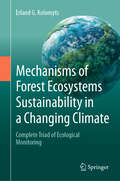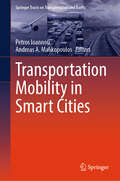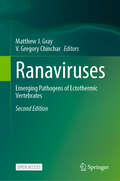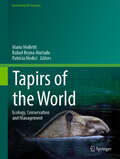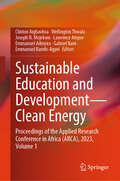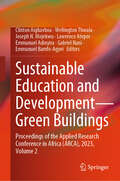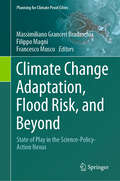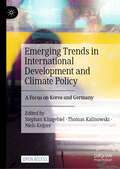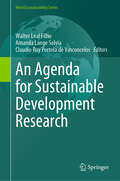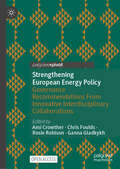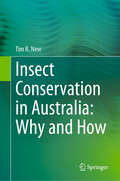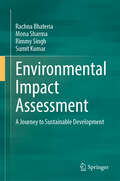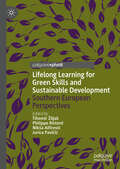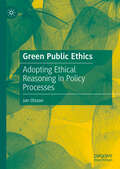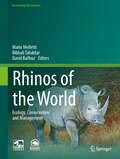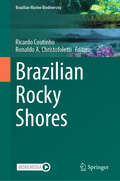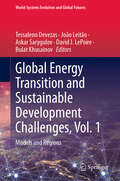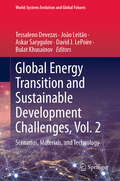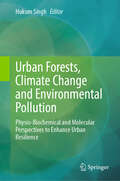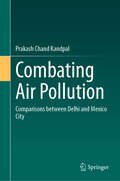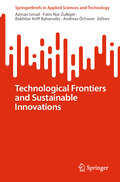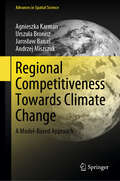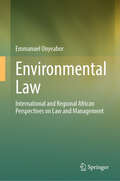- Table View
- List View
Mechanisms of Forest Ecosystems Sustainability in a Changing Climate: Complete Triad of Ecological Monitoring
by Erland G. KolomytsThe author's working concept of geo-ecological monitoring is presented. For the first time, the full triad of monitoring in its classical definition is considered: "observation (state assessment) – control (prediction) – management (adaptation, feedback, regulation)". The strategic goal of described monitoring research is to reveal the environmental otential of sustainablility of forest ecosystems in the context of modern global warming. The monograph expounds the main statements of author’s topo-ecological predictive concept: “Global Changes on the Local Level”, as a basis of ground bio-ecological and geosystem monitoring of natural ecosystems under global anthropogenic climatic changes. This concept makes it possible to carry out local empirical simulation of the regional bioclimatic trend and thereby reveal the mechanisms of transmission of global and regional climate signals to the local level. On the example of the Volga River basin, predictive empirical-statistical models of the carbon balance of forest ecosytems are presented under conditions of a changing climate. The carbon content in various pools of boreal and nemoral forests were calculated. The global climate models give prognostic estimates of the components of them carbon balance. A quantitative assessment of the ecological resources of forest formations that provide the environment sustainability through mechanisms of regulation of the carbon cycle is given. The adaptation of forest ecosystems to climate change is described through the calculated parameters of their functional sustainability.
Transportation Mobility in Smart Cities (Springer Tracts on Transportation and Traffic #21)
by Petros Ioannou Andreas A. MalikopoulosThis book covers multiple dimensions of future mobility systems in smart cities, mapping out the innovations that are needed, presenting ideas on how to address the challenges they present and exploring a holistic research path for future developments. The book considers the interaction between: technological developments in modes of transport and transportation systems like autonomous systems and shared mobility that lead to emerging mobility systems; the social behavior of the drivers and travelers who interact with these systems; and the institutional behavior of organized units such as the administrators responsible for the policies involved with transportation governance and regulation. Transportation Mobility in Smart Cities provides methods to analyze, design, and optimize a mobility system, taking into consideration this constellation of social and institutional factors as well as the necessary technological requirements. The result is a mobility system that will be acceptable to travelers without imposing undue inequities in transportation on the smart city. The holistic approach taken in addressing the problems involved with establishing a mobility system within a smart city makes this book attractive to researchers and practitioners, technologists, and policy makers alike. Graduate students working in areas connected with the evolution of transportation systems will also find the material presented in this book instructive.
Ranaviruses: Emerging Pathogens of Ectothermic Vertebrates
by Matthew J. Gray V. Gregory ChincharThis is a open access book. Ranaviruses, double-stranded DNA viruses (family Iridoviridae) that cause systemic, life-threatening disease in a variety of amphibians, reptiles and fish, have contributed to mass die-offs of both wild and captive populations around the globe. These viruses are emerging and increasingly responsible for population declines of ectothermic vertebrates. Because amphibians, reptiles, and freshwater turtles are suitable hosts and among the most imperiled vertebrate taxa in the world, ranaviruses can have significant impacts on biodiversity and ecosystem function. Additionally, many fish that are raised in aquaculture facilities and traded internationally are suitable hosts; thus, the potential economic impact of ranaviruses is significant. Ranaviruses also serve as a model for understanding viral replication and gene function among large double-stranded DNA viruses, e.g., poxviruses, asfarvirus, and ascoviruses. Lastly, study of the host immune response to ranaviral disease and the identification of viral immune evasion genes that negatively regulate host immune functions provide insight into which specific immune elements are most important in protecting host species against severe disease. The effort to produce a 2nd edition of our earlier work grew out of a recent meeting (1st Global Amphibian and Reptile Disease Conference) held in August 2022. Given the continued research in ranaviruses and ranaviral disease since the first edition, this new book updates the latest information on ranaviruses and provides guidance on how to monitor and manage ranaviruses in cold-blooded vertebrate populations.
Tapirs of the World: Ecology, Conservation and Management (Fascinating Life Sciences)
by Mario Melletti Rafael Reyna-Hurtado Patrícia MediciThis beautifully illustrated book is the first comprehensive work ever published on all four tapir species worldwide, filling a gap in the scientific literature. The book provides information on the systematics, phylogeny, evolution, ecology, conservation, and management of all tapir species. This volume is aimed at a wide range of readers, including researchers, wildlife managers, zoologists, conservation biologists, ecologists, veterinarians, zoo staff, students and environmental policy makers.
Sustainable Education and Development—Clean Energy: Proceedings of the Applied Research Conference in Africa (ARCA), 2023, Volume 1
by Clinton Aigbavboa Wellington Thwala Joseph N. Mojekwu Lawrence Atepor Emmanuel Bamfo-Agyei Emmanuel Adinyira Gabriel NaniThis book is Volume 1 of the proceedings of 2023 Sustainable Education and Development Research Conference. This volume concentrates on papers in the area of clean energy. Despite considerable progress, more than 700 million people worldwide still lack access to electricity, and around 2.4 billion people continue to use harmful and polluting fuels for cooking. While efforts have been made to promote renewable energy and energy efficiency, they have not been fast enough to achieve Sustainable Development Goal 7. Adding to the challenge, the ongoing war in Ukraine has contributed to rising global energy prices and heightened energy insecurity in Europe. In response to the energy crisis, some European countries are planning to accelerate the transition to renewables and increase investments in clean energy and energy efficiency. However, others are considering a resurgence of coal, which poses a risk to the overall green transition. Between 2010 and 2020, the percentage of the global population with access to electricity increased from 83% to 91%, with 1.3 billion people gaining access. Nevertheless, this leaves approximately 733 million people still without electricity, and most of them reside in sub-Saharan Africa. Achieving universal access by 2030, the annual growth rate in access needs to accelerate from 0.5 percentage points to 0.9 percentage points, necessitating significant efforts in low-income, fragile, and conflict-affected countries. In 2020, 69% of the global population had access to clean cooking fuels and technologies. While more than half of those without access to clean cooking fuels live in Asia, the 20 countries with the lowest percentage of people having access to clean cooking were predominantly least developed countries in Africa. The share of renewable sources in total final energy consumption reached 17.7% globally in 2019, just slightly higher than the figure for 2015. The electricity sector leads in the adoption of renewables, accounting for 26.2% of total final energy consumption in 2019, while the heat and transport sectors have made limited progress. Global primary energy intensity, defined as global total energy supply per unit of GDP, improved from 5.6 megajoules per dollar (2017 purchasing power parity) in 2010 to 4.7 megajoules in 2019. However, the rate of improvement (1.6% per year on average since 2015) falls short of the 3.2% annual rate needed to reach Sustainable Development Goal 7.3. International financial flows to support clean and renewable energy in developing countries reached $10.9 billion in 2019, a 23.6% decrease from 2018. This decline occurred even before the onset of the COVID-19 pandemic. Over a longer five-year moving average, average annual commitments decreased for the first time since 2008, from $17.5 billion in 2014-18 to $16.6 billion in 2015-19. Although developing countries achieved a record of 245.7 watts per capita in installed renewable energy-generating capacity in 2020, small island developing States, least developed countries, and landlocked developing countries have lagged behind. It would take least developed countries and landlocked developing countries nearly 40 years and small island developing States almost 15 years to reach the same level of progress as the average developing country in 2020. The 2023 SEDRC conference, titled "Sustainable Development and Education," aims to redefine the understanding of research in the continent's development and the role of researchers. The conference focusses on applied research discussions and its dissemination. Researchers from research institutions, academicians, postgraduate students, politicians, and industry representatives will be the primary audience for the conference proceedings.
Sustainable Education and Development—Green Buildings: Proceedings of the Applied Research Conference in Africa (ARCA), 2023, Volume 2
by Clinton Aigbavboa Wellington Thwala Joseph N. Mojekwu Lawrence Atepor Emmanuel Bamfo-Agyei Emmanuel Adinyira Gabriel NaniThis book is Volume 2 of the proceedings of 2023 Sustainable Education and Development Research Conference. This volume concentrates on papers in the area of green buildings. Despite considerable progress, more than 700 million people worldwide still lack access to electricity, and around 2.4 billion people continue to use harmful and polluting fuels for cooking. While efforts have been made to promote renewable energy and energy efficiency, they have not been fast enough to achieve Sustainable Development Goal 7. Adding to the challenge, the ongoing war in Ukraine has contributed to rising global energy prices and heightened energy insecurity in Europe. In response to the energy crisis, some European countries are planning to accelerate the transition to renewables and increase investments in clean energy and energy efficiency. However, others are considering a resurgence of coal, which poses a risk to the overall green transition. Between 2010 and 2020, the percentage of the global population with access to electricity increased from 83% to 91%, with 1.3 billion people gaining access. Nevertheless, this leaves approximately 733 million people still without electricity, and most of them reside in sub-Saharan Africa. Achieving universal access by 2030, the annual growth rate in access needs to accelerate from 0.5 percentage points to 0.9 percentage points, necessitating significant efforts in low-income, fragile, and conflict-affected countries. In 2020, 69% of the global population had access to clean cooking fuels and technologies. While more than half of those without access to clean cooking fuels live in Asia, the 20 countries with the lowest percentage of people having access to clean cooking were predominantly least developed countries in Africa. The share of renewable sources in total final energy consumption reached 17.7% globally in 2019, just slightly higher than the figure for 2015. The electricity sector leads in the adoption of renewables, accounting for 26.2% of total final energy consumption in 2019, while the heat and transport sectors have made limited progress. Global primary energy intensity, defined as global total energy supply per unit of GDP, improved from 5.6 megajoules per dollar (2017 purchasing power parity) in 2010 to 4.7 megajoules in 2019. However, the rate of improvement (1.6% per year on average since 2015) falls short of the 3.2% annual rate needed to reach Sustainable Development Goal 7.3. International financial flows to support clean and renewable energy in developing countries reached $10.9 billion in 2019, a 23.6% decrease from 2018. This decline occurred even before the onset of the COVID-19 pandemic. Over a longer five-year moving average, average annual commitments decreased for the first time since 2008, from $17.5 billion in 2014-18 to $16.6 billion in 2015-19. Although developing countries achieved a record of 245.7 watts per capita in installed renewable energy-generating capacity in 2020, small island developing States, least developed countries, and landlocked developing countries have lagged behind. It would take least developed countries and landlocked developing countries nearly 40 years and small island developing States almost 15 years to reach the same level of progress as the average developing country in 2020. The 2023 SEDRC conference, titled "Sustainable Development and Education," aims to redefine the understanding of research in the continent's development and the role of researchers. The conference focusses on applied research discussions and its dissemination. Researchers from research institutions, academicians, postgraduate students, politicians, and industry representatives will be the primary audience for the conference proceedings.
Climate Change Adaptation, Flood Risk, and Beyond: State of Play in the Science-Policy-Action Nexus (Planning for Climate Proof Cities)
by Francesco Musco Massimiliano Granceri Bradaschia Filippo MagniThis book includes the insights of a seminar that was held at IUAV University of Venice, on May 29th and 30th featuring 10 speakers. 8 speakers, 2 moderators, and 1 organizer from the seminar, plus 10 other authors contributed to this book. The writers’ expertise spans from local climate adaptation planning, public policy analysis, climate and environmental finance, and climate adaptation advocacy to multi-risk analysis, GIS, disaster risk management, ecosystem services assessment, urban geography, art, and civic engagement. The book contents address adaptation and flood risk mitigation along the Science-Policy-Action path - both theoretical and operative perspectives are discussed. EU climate adaptation policy and finance, climate adaptation implementation, flood risk analysis, nature-based solutions, blue ecosystem services, regional adaptation planning, and critical infrastructure adaptation are the topics investigated in depth by the writers.
Emerging Trends in International Development and Climate Policy: A Focus on Korea and Germany
by Stephan Klingebiel Thomas Kalinowski Niels KeijzerThis open access book delves into the considerable alignment of global sustainable development priorities between Germany and the Republic of Korea (hereafter referred to as Korea), despite their geographical separation. Notably, both nations share a common commitment to development policy and international climate action, an alignment that holds immense potential for enhanced cooperation in today’s evolving global landscape. Germany’s historical role as a founding member of the international development cooperation system juxtaposes with Korea’s more recent entry into the Organisation for Economic Co-operation and Development (OECD) and its Development Assistance Committee (DAC) in 2010. Korea has transformed from a significant development assistance recipient to an active provider, a transition mirrored in its engagement in international climate finance. Within this dynamic context, the book thoroughly examines key aspects such as the evolving development policy profiles of Germany and Korea, their roles in international organizations, and their shared commitment to international climate policies. It also explores avenues for deeper collaboration between these like-minded partners, all against the backdrop of an evolving geopolitical focus, including the new Indo-Pacific emphasis.
Reviving Aleppo: Urban, Legal and Digital Approaches for Post-War Recovery (Cities, Heritage and Transformation)
by Fabian Thiel Rahaf OrabiThis book provides indispensable and interdisciplinary insights into the revitalization and redevelopment of urban centers in war-stricken conflict regions, such as Aleppo in northern Syria. This contribution explores innovative, cutting-edge toolkits for academicians, digital building technologists, engineers, architects, archeologists, (urban) planners, land policy advisors and legal scholars. The compendium not only analyzes strategies and shortcomings of implementation guidelines drawn by donor organizations, development agencies and political actors, but also explores possibilities for initiating functioning and sustainably resilient networks that can establish capacity-building platforms for recovery and reconstruction. Although the work focuses on a city in Syria, it holds lessons, toolkits and instruments for other areas in the region and beyond.
An Agenda for Sustainable Development Research (World Sustainability Series)
by Walter Leal Filho Amanda Lange Salvia Claudio Ruy Portela de VasconcelosThis book involves establishing a set of priorities and a roadmap that can guide scholarly and practical efforts towards sustainability goals. It encourages collaboration across disciplines to address complex sustainability issues that span social, economic, and environmental domains. It also supports the development of robust methodologies for conducting research, including quantitative, qualitative, and mixed methods approaches. But despite the importance of and the need for an agenda for sustainable development research, many efforts are isolated and thematically disconnected. Also, it is difficult to find information on how sustainability research is being undertaken and on the wide range of methods being used. Against this backdrop and in order to facilitate a broad discussion on the contribution of sustainable development research, this book is being produced. The book gathers inputs from universities and research organisations working on matters related to sustainable development research in a variety of contexts. It also provides a platform for the dissemination of information on the latest initiatives, paving the way for technology transfer and networking. Furthermore, the book intends to provide a fertile basis upon which universities, research centres, and practitioners may cooperate more closely in this key area. Last but not least, a further aim of the book is to present methodological approaches and experiences deriving from case studies and projects, which aim to show how sustainability research may be implementing across a range of disciplines. Thanks to its scope and interdisciplinarity, this books makes an excellent reading to everyone interested on sustainability research.
Strengthening European Energy Policy: Governance Recommendations From Innovative Interdisciplinary Collaborations
by Chris Foulds Rosie Robison Ami Crowther Ganna GladkykhThis open access book foregrounds novel collaborations between the Social Sciences and Humanities (SSH), and Science, Technology, Engineering and Mathematics (STEM) disciplines, for the benefit of European energy policy. Each chapter has been led by a team spanning social and technical disciplines. The book proposes 10 policy recommendations to: Simplify the uptake of community energy; Prioritise societal engagement in geothermal; Create co-learning for energy communities; Facilitate energy literacy; Support place-based strategies for retrofit; Promote integrated policy design for agrivoltaics; Increase social acceptability of low-carbon technologies; Protect digital energy infrastructure; Understand stakeholder perceptions of energy-efficiency measures; and Rethink energy system models to support the just transition. It will be of interest to anyone developing, implementing or critiquing energy policy (locally, nationally or internationally) as well as those looking to expand the use of interdisciplinary research to achieve sustainability goals. Part of a three-volume collection covering climate, energy, and mobility policy.
Insect Conservation in Australia: Why and How
by Tim R. NewThe fundamental ecological, cultural and economic roles of insects give them central importance in functioning of terrestrial and inland water ecosystems worldwide. Insect declines, from a variety of anthropogenic threats, erode these services and dictate the need for insect conservation, but the consequences of insect losses are poorly recognised. In Australia, insect conservation must proceed from a very uncertain and incomplete knowledge of insect identifications and diversity, and also from a generally poor public appreciation of their central ecological roles and relevance to human welfare and other biota. These impediments occupy much of this book, in which cases of insect conservation across the world are used to provide lessons for Australia, where a combination of large numbers of insect species and small numbers of entomologists and citizen participants necessitates clear appreciation of insect importance, and focussed conservation priorities. Low public sympathy and inadequate scientific information can hinder progress because uncertainty, imprecision and ignorance are difficult to explain to policymakers and funding agencies whose interest and support may be pivotal. Understanding and overcoming those impediments is a vital component of insect conservation. This book is intended as an introduction to the needs, rationale and practice of insect conservation in Australia for students in conservation biology, managers and other concerned people who are not specialists in entomology, to whom the daunting variety and complexity of insect life may deter involvement, and for whom an Appendix aid to recognising insect orders is included. The text is based on conservation needs of Australia’s insects and shows how progress necessitates effective communication, clear priorities, and plans for action within a realistic and practical framework of aims and needs for practical conservation. A suggested ‘Agenda’ for advancing insect conservation in Australia encompasses many of these needs and activities.
Environmental Impact Assessment: A Journey to Sustainable Development
by Mona Sharma Sumit Kumar Rachna Bhateria Rimmy SinghThis book will cover the basic principles and salient features of EIA. The authors attempt to cover the shortcomings observed in EIA reports, the manner of conducting EIA for proposed projects, and also to facilitate the preparation of good quality EIA reports. The book is written in a straightforward format avoiding long descriptive texts to enhance the reader experience Although the focus is on the Indian context, the concepts and techniques of EIA described in this book are applicable universally. An Environmental Management Plan (EMP) is also discussed, and this is an essential aspect of EIA in countries where priority is on economic development by way of development projects and when the EIA process has inherent weaknesses. For the continual improvement of EIA reports, EIA consultants maybe assigned the task of implementing and operationalizing the suggested EMP in addition to conducting an EIA study and in preparation of an EIA report. The system of peer review of EIA reports is also expected to improve EIA quality. “Environmental Impact Assessment: A Journey to Sustainable Development” is an attempt to cover EIA according to new knowledge acquired through research and experiences which will make this tool more versatile and dynamic. The authors recognise that since EIA is continuously expanding and developing there will always be potential for improving the scope of this book to make it more useful to the users as per their requirement. This book will be of interest to academics, EIA professionals and consultants, EIA review/appraisal authorities and particularly stakeholders in emerging economies where major developmental work is being undertaken and which is expected to continue in decades to come.
Lifelong Learning for Green Skills and Sustainable Development: Southern European Perspectives
by Nikša Alfirević Jurica Pavičić Tihomir Žiljak Philippe RistordThis edited book analyses the implementation of green transformation policies and the UN Sustainable Development Goals across the European Union, in the context of lifelong learning and educational practices. The contributions examine how green skills became mainstreamed in member states’ education policies, as well as the social, economic and political circumstances contributing to this process. A focus on lifelong learning (from an early age to adulthood) is maintained throughout the volume, and the book will appeal to researchers, students, policy- and decision-makers in education, environmental and social studies.
Green Public Ethics: Adopting Ethical Reasoning in Policy Processes
by Jan OlssonThis book argues that ethical reasoning should be adopted into policy processes in order to improve environmental regulations. It considers how public administrators and civil servants play key roles in policy making and implementation, and demonstrates how the inclusion of green public ethics at every stage of the policy process could drastically enhance sustainable development initiatives. Filling an important void in the literature on policymaking and environmental ethics, the book draws from empirical case studies to demonstrate how ‘green’ ethical reasoning can be utilised by practitioners and stakeholders in democratic governments. It will appeal to all those interested in public policy, public administration, philosophy and environmental studies.
Rhinos of the World: Ecology, Conservation and Management (Fascinating Life Sciences)
by Mario Melletti Bibhab Talukdar David BalfourThis book represents the culmination of more than four years of work by many rhino experts, primarily from Africa, Asia, the United States, and Europe, involved in rhino conservation, research and management. It is one of the most comprehensive reference works ever published on the systematics, ecology, conservation status, and management of all rhinoceros species. Covering all five rhino species worldwide, this volume brings together the contributions of 92 international rhino experts and provides: A comprehensive overview of the current state of knowledge on the evolution, phylogeny, systematics, and fossil record of rhinos An in-depth look at the ecology and conservation status of each species, with detailed chapters A series of case studies on conservation management, poaching, horn trade, and ex-situ programs. This beautifully illustrated book is an invaluable resource for researchers, wildlife managers and professionals in conservation biology, ecology, and management, as well as the general public. It reveals the fascinating story of rhino evolution, the long history of human interactions with rhinos, and the major threats to these iconic species.
Brazilian Rocky Shores (Brazilian Marine Biodiversity)
by Ricardo Coutinho Ronaldo A. ChristofolettiRocky shores correspond to a very particular habitat in Brazil, which is concentrated in the Southeastern and Southern coasts. There are different types of substrata and seascapes that cause a high environmental heterogeneity responsible to host a high species biodiversity and a range of ecosystem services. Primary and secondary production, as well as structuring organisms and processes, differs from temperate areas.
Global Energy Transition and Sustainable Development Challenges, Vol. 1: Models and Regions (World-Systems Evolution and Global Futures)
by João Leitão Tessaleno Devezas Askar Sarygulov David J. LePoire Bulat KhusainovThis two-volume book presents the challenges of the global energy transition, offering a comprehensive exploration of the policies and drivers shaping the pace and trajectory of this transformation. Highlighting regional development, the book shows how different models and scenarios of energy transition emerge. It discusses important factors, such as materials and technologies, shedding light on the opportunities and constraints for the energy transition. Global warming and climate change influenced the change in people’s consciousness and their awareness of the need for more limited use of hydrocarbon resources. Changes in weather conditions, rising sea levels, and destructive climate events such as hurricanes, forest fires, droughts, floods, etc. have become more frequent. Many countries around the world, reacting to these changes, have developed long-term plans to actively replace fossil fuels - gas, oil, and coal with renewable energy sources, mainly solar and wind. However, the low replacement rates observed in the global energy sector over the past 30 years raise the question of how far the decarbonization scenarios and models being implemented by many countries bring us closer to the ultimate goal of creating an economy with a low carbon footprint. Seeking answers, the volumes feature 22 chapters split across the two books, which in detail discuss various aspects of the energy transition and their impact on the sustainability of economic development and the future of energy. This first volume, "Models and Regions," focuses on regional disparities and economic drivers, presenting case studies from different regions in 10 chapters.
Global Energy Transition and Sustainable Development Challenges, Vol. 2: Scenarios, Materials, and Technology (World-Systems Evolution and Global Futures)
by João Leitão Tessaleno Devezas Askar Sarygulov David J. LePoire Bulat KhusainovThis two-volume book presents the challenges of the global energy transition, offering a comprehensive exploration of the policies and drivers shaping the pace and trajectory of this transformation. Highlighting regional development, the book shows how different models and scenarios of energy transition emerge. It discusses important factors, such as materials and technologies, shedding light on the opportunities and constraints for the energy transition. Global warming and climate change influenced the change in people’s consciousness and their awareness of the need for more limited use of hydrocarbon resources. Changes in weather conditions, rising sea levels, and destructive climate events such as hurricanes, forest fires, droughts, floods, etc. have become more frequent. Many countries around the world, reacting to these changes, have developed long-term plans to actively replace fossil fuels - gas, oil, and coal with renewable energy sources, mainly solar and wind. However, the low replacement rates observed in the global energy sector over the past 30 years raise the question of how far the decarbonization scenarios and models being implemented by many countries bring us closer to the ultimate goal of creating an economy with a low carbon footprint. Seeking answers, the volumes feature 22 chapters split across the two books, which in detail discuss various aspects of the energy transition and their impact on the sustainability of economic development and the future of energy. This second volume, "Scenarios, Materials, and Technology," explores mechanisms and technological drivers for a sustainable transition in 12 chapters, from local industries to national economies.
Urban Forests, Climate Change and Environmental Pollution: Physio-Biochemical and Molecular Perspectives to Enhance Urban Resilience
by Hukum SinghThis book contributes significantly to the international literature by bringing forth a novel and comprehensive exploration of urban resilience in the face of climate change and environmental pollution. Its focus on integrating physiological, biochemical, and molecular dimensions distinguishes it from existing literature. The book offers several key contributions, including an interdisciplinary approach to understanding the complex interactions within urban ecosystems. It includes cutting-edge insights that have not been extensively explored in existing literature, practical applications, and evidence-based strategies to enhance urban sustainability and resilience. The book has a global relevance to a diverse international readership and provides strategic guidance to policymakers and urban planners when making decisions to develop evidence-based strategies that cater to the specific challenges of cities. Urban forests play a critical role in enhancing the resilience of cities by providing numerous benefits, including improved air quality, reduced urban heat island effect, and enhanced biodiversity, ultimately improving urban health. Besides, urban forests are a crucial natural-based solution (NbS) to mitigate air pollution and climate change impacts in cities. However, in the face of climate change and environmental pressures, urban forests face significant challenges to their survival and functionality. This book explores the complex morpho-physio-biochemical and molecular changes that enable urban forests to flourish amidst climate change and environmental pollution. It examines how urban trees modulate their morphological structures, including root systems and physiological and biochemical functioning, and molecular alterations to withstand changing urban climatic and environmental conditions.
Combating Air Pollution: Comparisons between Delhi and Mexico City
by Prakash Chand KandpalThe primary objective of this book is to probe into the menace of air pollution in Delhi, which has emerged as the main threat to public health and the environment in the capital city. The book explores the viable solutions to the problem, examines the existing policies and programmes developed by the Government and the policy makers to address the issue, traverse the hurdles in the implementation of these policies and reveals the politics over air pollution in Delhi. It also discusses about the other highly polluted cities of the world, specifically Mexico City, which has faced environmental emergencies due to air pollution in the past, and how these cities have prepared themselves to combat the menace of air pollution, and what can be learnt from their experiences to face the same situations in Delhi. The book examines how air pollution is being addressed in the context of environmental policy frameworks and politics, and will be of use to policy makers, researchers, governmental and non-governmental agencies working to combat air pollution in major cities.
Science-Policy Interfaces in Global Environmental Governance: Myths, Challenges and Opportunities (SpringerBriefs in Political Science)
by Matteo De DonàThis Brief discusses science–policy interfaces (SPIs) in global environmental governance. Broadly speaking, SPIs can be understood as institutional arrangements that aim to bridge science and policy within a specific issue-area with a view to facilitating the solution of relevant societal problems. Although the scholarly literature on SPIs has grown substantially over the last two decades, there are still several myths and misconceptions about such bodies: these are often reflected in the practice of science–policy bridging within international organizations such as the United Nations. Offering an accessible discussion of the promises and pitfalls of SPIs, the book deliberately targets a hybrid audience, reaching out to both academics and practitioners. By reconstructing relevant theoretical debates across different scholarly fields, such as International Relations and Science and Technology Studies, and by taking stock of key hands-on experiences, this Brief connects the theory and practice of global SPIs, reflecting on the role of critical social science research as far as the interplay between science and policy in international environmental governance is concerned. On the basis of a balanced analysis of the strengths and shortcomings of global SPIs, this volume intends to provide readers with a faithful picture of the current international science–policy landscape as well as with an informed opportunity to evaluate these institutional arrangements’ potential for helping to address the global environmental challenges that the world is facing today.
Technological Frontiers and Sustainable Innovations (SpringerBriefs in Applied Sciences and Technology)
by Andreas Öchsner Azman Ismail Fatin Nur Zulkipli Bakhtiar Ariff BaharudinThis book takes a deep dive into the industrial sphere, exploring subjects such as aerospace development, knowledge management in higher education, and the emergence of a nation as a player in the global space race. This insightful compilation of chapters offers an essential guide to navigating the complexities of modern industry, offering valuable insights and solutions to propel businesses and society toward a sustainable future.
Regional Competitiveness Towards Climate Change: A Model-Based Approach (Advances in Spatial Science)
by Andrzej Miszczuk Agnieszka Karman Urszula Bronisz Jarosław BanaśThis book analyzes the competitiveness of European regions and presents forecasts for 2030 and 2100 under different climate scenarios. It examines the economic impact of climate change from a regional economic perspective and sheds light on various factors that influence regional competitiveness and development. Furthermore, the authors derive reflections on EU climate policy and policy recommendations from the empirical results, which will help both scientists and regional decision-makers to implement policy measures and develop successful adaptation processes for the regions and countries of the EU to climate change.
Environmental Law: International and Regional African Perspectives on Law and Management
by Emmanuel OnyeaborThis book offers an overview of environmental law from both an international and regional perspective, focusing on global issues while at the same time offering uniquely African insights. The book addresses environmental issues, principles, and policies from the standpoints of law and management. There is a growing need for books on environmental law that integrate environmental issues, principles and policies in a single source to guide practitioners in the fields of environmental studies and environmental law. This book covers the corresponding principles, theories, procedural rights, international and regional strategies, liabilities and remedies for environmental damage, including in/to the marine environment. Topics addressed include atmospheric pollution, water pollution, marine pollution, land use, and waste management. Given its scope, the book will be of interest to practitioners in the fields of environmental studies and environmental law, corporations, policymakers, judges, students, and all others who are concerned with environmental issues, principles, policies and the law.
